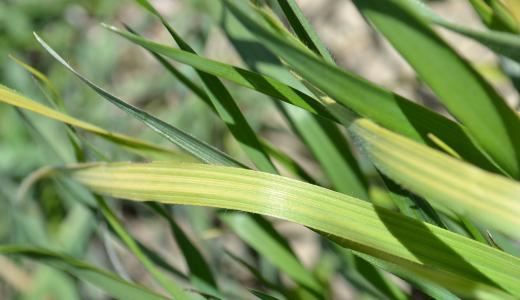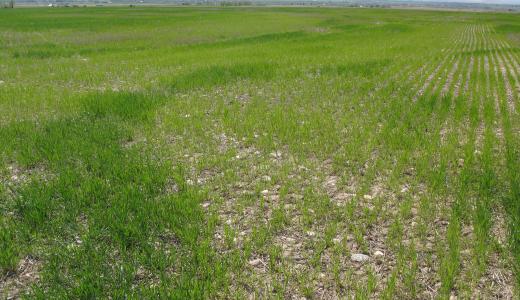
Pythium and cold damage issues on winter wheat and pulses
The Schutter diagnostic lab has recently received plant samples with symptoms of frost damage. Cold injury is often found on crops in low-lying areas where cold air presides, and damage is often sporadic in the field. Severity of the symptoms depends on the duration and intensity of the cold snap and the crop growth stage. Cold soil also interferes with the uptake of nutrients by plants, which can lead to nitrogen, iron, and zinc deficiency. Cold and wet soils are also prime conditions for Pythium root rot.
Cold damage in wheat: When temperatures dip in the spring, wheat leaves may show injury as yellow tips and dying tissue (Fig. 1). Stems may also split, interrupting plant water and nutrient uptake. Symptoms can be bleached areas or a water-soaked appearance. This can lead to lodging and plant collapse. Wheat spikes may die off, initially indicated by leaf yellowing in the whorl. Yellowing will increase if the culm declines. In spring wheat, color banding (yellow, white, brown, purple bands) can be apparent when temperatures fluctuate from day to night.
 Figure 1. Wheat with yellowing, Photo: Mary Burrows |
Pythium damage in wheat: Pythium species are soilborne and can degrade plant seeds prior to emergence or infect root tissue. Cold and wet spring weather in fields with high residue levels are ideal conditions for Pythium infection. Symptoms are often sporadic and worse in low-lying areas (where moisture gathers). Pythium symptoms include poor stand, yellow seedlings, reduced tillers, stunted roots, brown roots, minimal root hairs, or a lack of lateral roots (Fig.2).
 Figure 2: Wheat field with Pythium issues. Photo: Mary Burrows. |
Cold damage in pulse crops: Cold injury of dry pea, lentil, and chickpea often shows up as leaf damage, which initially appears water-soaked then becomes brown, found predominantly in the interveinal tissue. Necrotic plant tissue may be confined to a single node / growing point. Chickpeas are quite affected by frost, with leaves on the top of plants turning yellow or white and looking dry. This damage can be concentrated in the leaf margins.
Pythium damage in pulse crops: Pulse crops affected by Pythium in the soil will appear stunted, with light brown roots, show poor vigor, and secondary roots may be pinched off. Seed may also decay, leading to poor crop establishment.
To submit a sample, please visit the Schutter Diagnostic Lab site, Ph: 406-994-5150
Carmen Murphy | Ph: 406-994-5162
[email protected]